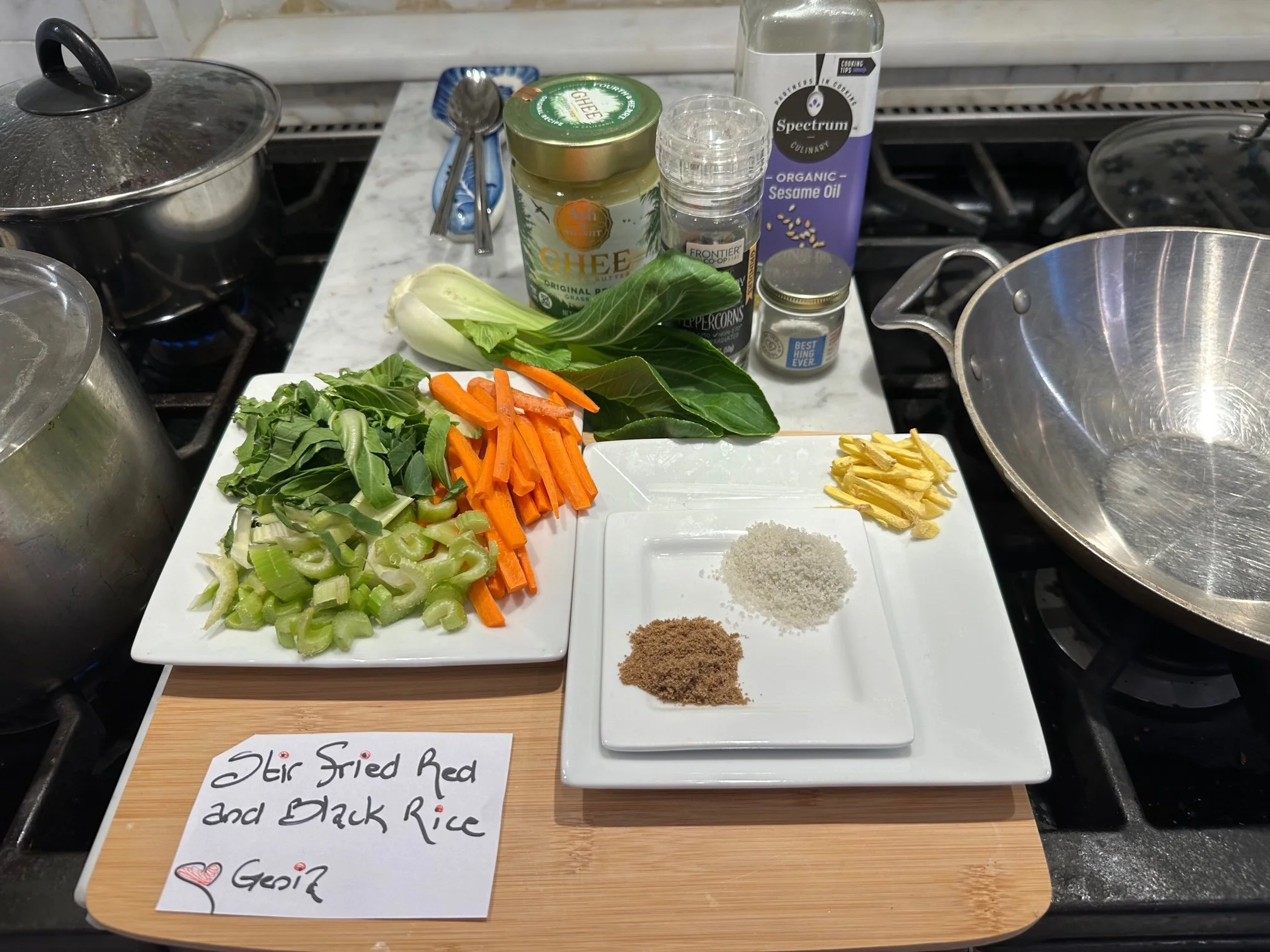Stir Fried Red And Black Rice
I’ve been eating a lot of rice lately. Knowledge is power, and I’m certainly learning what makes my gut happy, and that means digestive bliss. Food is medicine! We all need to remember that. When I shop for rice I look for high quality grains: organic, white rice (easier to digest - Lungberg RIce), high quality red and black (forbidden) rice (Lotus Foods) which has many antioxidants, fiber, and protein. Some use black rice in desserts. How cool is that?! Rice is nourishing and energizing and balancing, gluten-free and has a slightly sweet taste. Rice is your friend not foe.
Divya Alter - my teacher shares this recipe in her cookbook What To Eat For How You Feel. I made a few modifications - less salt, and left out the cashews as a garnish - cooks choice, of course. Divya made her own Ayurvedic modifications after being inspired by the authors of Green Kitchen Travels.
In Ayurveda texts (ancient Indian medical system - natural and holistic approach to physical and mental health) Ayurveda glorifies red rice as one of the best types of rice because it is low glycemic and balancing for everybody. It cooks in 20 minutes. Black rice (aka forbidden rice) originated in ancient China, where it was known as ‘longevity rice’ and was reserved for the emperors. Both rices are an excellent source of minerals.
mise en place
Recipe - serves 4
1/4 cup black rice - rinsed, soaked for 30 minutes and drained
3/4 cup red rice - rinsed, soaked for 30 minutes and drained
1 tsp salt
1 tbsp ghee or sesame oil or coconut oil
1 tbsp thinly julienned fresh ginger
1 tsp ground coriander
optional: small pinch of hing - asafoetida
1 large carrot, cut into 1/4 inch wide and 2 inch long strips
2 celery sticks, thinly sliced
1 head baby bok choy or spinach - 1 cup full
1/4 tsp freshly ground black pepper
Garnishes:
1 tsp ghee, sesame oil, or coconut oil
or
small handful fresh basil leaves, torn into pieces
soaking my red and black rice for 30 minutes - rinse and drain
red and black rice cooks differently and preserves their gorgeous colors for the dish - food is art
sautéing julienned ginger root
Instructions
combine the black rice with 1 1/2 cups water and 1/4 tsp salt. Bring to a boil over medium-high heat, then lower the heat, cover, and simmer for 30 to 40 minutes until the grians are soft. Drain any excess water and set aside uncovered for 5 minutes until grains firm up. Fluff with a fork.
In another small saucepan, combine the red rice with 2 cups water and 3/4 of the teaspoon salt. Bring to a simmer over medium-high heat, then lower the heat, cover, and simmer for 20 minutes, or until the grains are soft. Drain any excess water and set aside uncovered for 5 minutes to let the grains firm up. Fluff with fork.
While the rice is cooking, heat 1 tbsp ghee in a wok or skillet over high heat. Add the ginger and crisp it for 15 seconds, then add the following ingredients in consecutive order: coriander, hing (optional), 1/2 tsp salt, carrot, celery, and bok choy or spinach.
stir-fry for 5 to 10 minutes, until the vegetables are crisp, tender and slightly browned in parts.
cover pan with a lid for the last 3 minutes to speed up the cooking.
season with the pepper.
add the cooked black rice and red rice, reduce heat to medium-high, and stir-fry for another 3 to 4 minutes, until the grains are warmed through.
Genia’s Spoon Me Tips
Cooking the black and red rice separately preserves their distinct color when you add to the entire dish. If you cook together, the black rice will overpower the red rice.I made the hing (asafoetida in english) ingredient optional. A little goes a long way, and worth exploring. You can find hing on the internet. The spices used in hing creates a unique taste and aroma. Hing comes from Afghanistan and Iran. “The taste can be shocking for a western palette,” says Kate O’Donnell, author of The Everyday Ayurveda Cookbook. She offers it as an optional spice in her recipes.
You can serve the rice with sauteed leafy greens, broccoli rabe, and cauliflower - these are great ways to add more greens into your diet.
Much Love,
Genia





